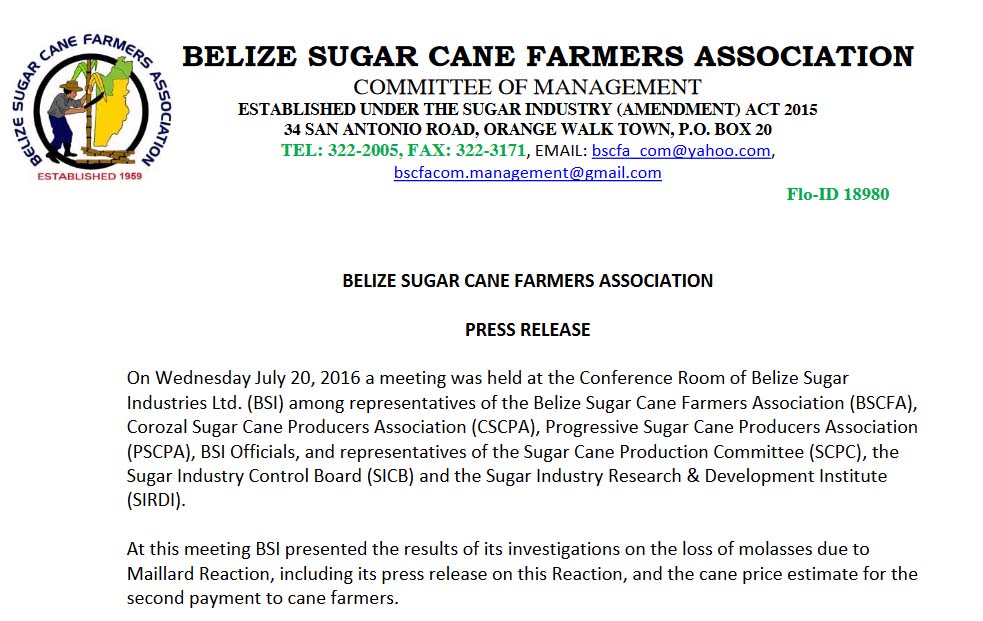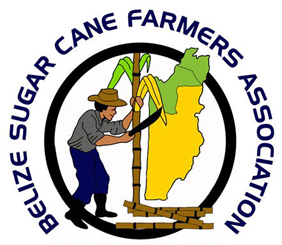
Molasses and Second Payment Estimate for July 20 2016
On Wednesday July 20, 2016 a meeting was held at the Conference Room of Belize Sugar
Industries Ltd. (BSI) among representatives of the Belize Sugar Cane Farmers Association (BSCFA),
Corozal Sugar Cane Producers Association (CSCPA), Progressive Sugar Cane Producers Association
(PSCPA), BSI Officials, and representatives of the Sugar Cane Production Committee (SCPC), the
Sugar Industry Control Board (SICB) and the Sugar Industry Research & Development Institute
(SIRDI).
At this meeting BSI presented the results of its investigations on the loss of molasses due to
Millard Reaction, including its press release on this Reaction, and the cane price estimate for the
second payment to cane farmers.
In its press release BSI stated that “the Millard Reaction at BSI is attributed mainly to the quality
of cane received with high levels of reducing sugars combined with high ambient temperatures
during the 2016 crop”. The BSCFA expressed its disapproval of this statement, which sought to
place blame and responsibility for the Millard reaction mainly and squarely on the cane farmers.
The BSCFA indicated that “the chief cause of the spontaneous decomposition of molasses in
storage is attributed by Brownie to the reaction of unstable organic substances (originally
produced by the action of lime upon the reducing sugars of the cane during clarification) with
further quantities of reducing sugars in the molasses, which results in the formation of dark
coloured colloidal reactive impurities of high carbon content. Furthermore, the BSCFA pointed out
that the laboratory test results showed that the quality of cane delivered by cane farmers during
the 2015/2016 crop was good in relation to the quality parameters for the acceptance and
rejection of cane stipulated in the commercial agreement signed between BSCFA and the other
Associations. In plain and simple terms, the cause of the Millard effect cannot be attributed to
the quality of cane.
BSI estimates that 3,900 tons of molasses was lost as a result of the Maillard Reaction. BSI has
included this loss in its estimated cane price for the second payment to cane farmers for the
2015/2016 crop. This loss amounts to $432,666, which will be shared in the proportion of 65% by
cane farmers and 35% by BSI. The effect of this loss on the estimated cane price of cane to be paid
to cane farmers is, therefore, $0.22 per ton of cane. As a result, the estimated average price for
the second payment will be $48.08 per ton instead of $48.30 per ton.
The BSCFA, however, has objected to the sharing of this loss, and has stated that this loss should
be borne completely by BSI. The commercial agreement does not provide for the inclusion of such
loss of molasses in the calculation of the cane price to be paid to cane farmers. In fact, the
agreement states that “ownership of any sugar cane purchased ...shall transfer to BSI when the
cane is weighed and ticketed at the factory scales”. The Agreement also states that “prior to a load
of cane being weighed and ticketed at the factory scales, cane may be rejected in accordance with
the process and criteria set out in the Agreement”. Hence, the cane farmer expects to receive
payment for his cane in accordance with the quality accepted at the scales.
It follows, therefore, that BSI has sole responsibility for the cane thereafter and for all products
extracted from this cane, name molasses, sugar and energy. Whatever happens to these products
during the manufacturing and storage processes is the sole responsibility of BSI, and hence any
losses that occur in these processes should be borne fully and solely by BSI. The cane farmers
should not be made to bear any losses in these processes. The Agreement covers losses from the
moment the product is being loaded from the storage point at BSI unto the barges up until the
point it is being discharged at the port of delivery to the buyer such as Tate & Lyle Sugars.
The BSCFA further pointed out that the estimated price used to calculate the revenues from the
export of molasses is less than the price reflected in the contract with the buyers of molasses. As a
result, cane farmers will be paid a lower estimated cane price than that to which they should be
entitled. The BSCFA considers this to be an unfair trading practice by BSI.
The BSI indicated that it has noted the comments and requests for changes to the estimated cane
price made to them by BSCFA. Nevertheless, the BSCFA is requesting that the Sugar Industry
Control Board take the following actions:
1. Conduct an independent investigation into the loss of molasses from the Millard
Reaction;
2. Have BSI assume the entire financial loss of revenues as a result of the loss of molasses;
3. Have BSI revise the estimated average price of cane to be used for the second payment
to cane farmers for the 2015/2016 crop by using the actual contract price for the
export sale of molasses.
The cane farmers are already suffering the brunt of low sugar and cane prices. It is not fair for
them to bear the additional burden of the financial losses from the loss of molasses and to be
deprived of income through the use of an incorrect export price for molasses.



